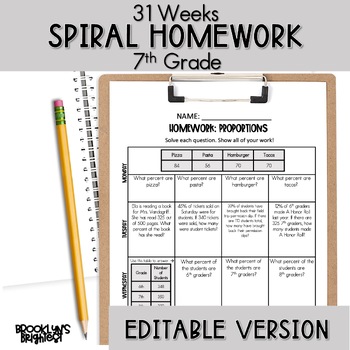7th Grade Math Spiral Review Homework Editable Entire Year
- Zip
Also included in
- This editable 6-8th grade middle school math spiral homework is perfect for the teacher who does not wanted to be overwhelmed with spiral review. Each week has a theme, so you are able to review by chunking material. There are 93 weeks included to last the entire year for each grade. There is an ediPrice $50.40Original Price $63.00Save $12.60
Description
This fully editable 7th grade math spiral homework is perfect for the teacher who does not wanted to be overwhelmed with spiral review. Each week has a theme, so you are able to review by chunking material. There are 31 weeks included to last the entire year.
There is a fully editable PowerPoint version in this download!
Topics included:
Rounding Decimals
Algebraic Expressions
Data & Stats
Mean of Absolute Deviation
Area
Volume & Surface Area of Prisms
Percents Part One
Percents Part Two
One Step Equations
Two Step Equations
Angle Relationships
Area of Circles
Circumference of Circles
Distributive Property Positives Only
Inequalities Part One
Inequalities Part Two
Ratios
Proportions
Proportional Tables
Triangles
Probability
Tax, Tip, Discounts
Distributive a Negative
Percent Change
Unit Rate
Integer Operations
Fraction Operations
Part One
Fraction Operations
Part Two
Fraction Operations
Part Three
Fraction Operations
Part Four
Independent & Dependent Variable






